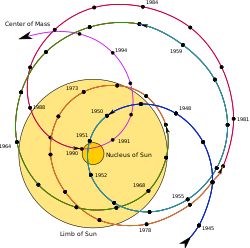Astrometry
Astrometry is a part of astronomy that has to do with measuring the motion of objects in space such as stars. Two main ways to measure these objects are proper motion and parallax.
Proper motion is an object’s change in position over time when seen from the Earth. Just like anything else that moves, a star's proper motion is measured by looking towards the same place at different times and seeing how far the star has moved. The difference with stars is that, from Earth, they seem to move very slowly so we have to measure in arcseconds per year. When a star has a large proper motion, it usually means that it is nearby. Barnard’s Star, the star with the largest proper motion, only moves 1 degree across the sky (3600 arcseconds) in 348 years.
Parallax is the apparent difference in position of an object when seen from two or more different places. When an object is seen from a new place, there is a new line of sight going from the viewer to the object showing a different background in the distance. Parallax is measured using the angle between two lines of sight.
Parallax can also be used to measure distances to the nearest few thousand stars. These distances are measured in parsecs which are equal to about 3.26 light years.
Astrometry Media
Illustration of the use of interferometry in the optical wavelength range to determine precise positions of stars. Courtesy NASA/JPL-Caltech
Concept art for the TAU spacecraft, a 1980s era study which would have used an interstellar precursor probe to expand the baseline for calculating stellar parallax in support of Astrometry.
Diagram showing how a smaller object (such as an extrasolar planet) orbiting a larger object (such as a star) could produce changes in position and velocity of the latter as they orbit their common center of mass (red cross).
Motion of barycenter of solar system relative to the Sun
References
- http://www.answers.com/topic/proper-motion. Retrieved on 3 September 2009.
- Rowan-Robinson, Michael. Cosmology: Third Edition. Clarendon Press, Oxford: 1996.



